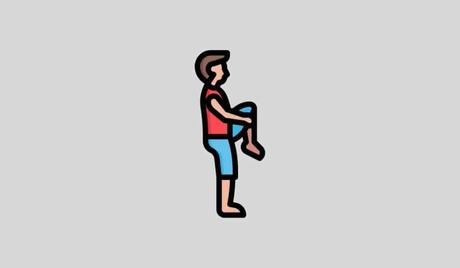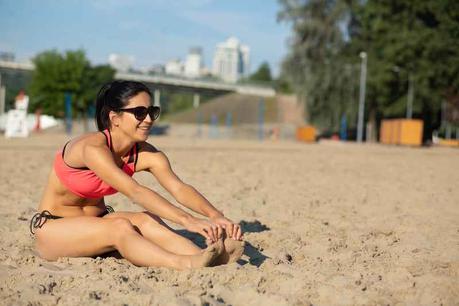Stretching regularly decreases injury and improves performance and mobility. Here’s a full-body stretching routine anyone can do daily, including step-by-step instructions and benefits.

Stretching is an absolutely critical part of any healthy workout program!
Not only does stretching build muscle, but it also increases your range of motion so you can grow stronger and more flexible/mobile.
It’s as important to your workouts as lifting weights or running, so you should never skip your stretches before and after every training session.
Below, we’re going to look at a simple yet highly effective full body stretching routine that will help you to limber up from head to toe in just a few minutes.
Go through this routine before and after your workouts—and a few extra times a week around your house or at the office—and I guarantee you’ll move more easily through every activity.
Let’s get after it.
Benefits of Full Body Stretching
Before we get into the full body routine, let’s take a moment to talk about the benefits of stretching—or, put another way, all the reasons that you should be stretching regularly.
 Increasing Active and Passive Range of Motion
Increasing Active and Passive Range of Motion

Active range of motion refers to how far you can flex or stretch a muscle/joint. For example, when you reach behind to scratch your back. Your muscles are propelling the stretch, therefore it’s “active”.
Passive range of motion, on the other hand, refers to how far your muscles/joints can be stretched. For example, when you do an over-the-head shoulder stretch, using one arm to pull the other deeper into the stretch.
Stretching regularly increases both your active and passive range of motion (depending on how you stretch, of course), which ultimately helps you to move more easily and completely without risking injury.
 Decreasing Injury Risk
Decreasing Injury Risk

This is one of the best reasons to spend time stretching (both static and dynamic stretching).
Stretching loosens up stiff joints and increases your range of motion, both of which will decrease your injury risk. When your joints and muscles are limber and flexible, they can flex and bend with your twisting, jumping, crouching, and leaping movements.
With a higher range of motion, those same movements will be less likely to over-extend (sprain/strain) your muscles and joints.

 Improves Posture
Improves Posture

Stretching isn’t just about how long it takes to get flexible or do the splits.
(Though if you’re interested in doing the splits, I’ve got an article on Stretching Routine for Front Splits: Stretches, Tips and Step-by-Step Instructions that may come in handy).
Really, one of the major benefits of stretching is that it elongates your spine, stretches out your hips and pelvis, and helps to loosen up stiff muscles in your core and lower body.
As a result, you’ll notice huge improvements in your posture. You’ll stand straighter, feel less tension in your muscles and joints, and ultimately move more easily through every activity and movement.
It’s worth the time invested because of how much it will improve the way you stand, sit, walk, run, and even lie down!
 Relieves Stress
Relieves Stress

There is something truly wonderful about whole-body stretching! By pulling on those tight, stiff muscles, you can actually reduce the amount of stress and tension accumulated in your body.
You’ll find that the physical relaxation of stretching can translate into better mental relaxation, too. Just those few minutes spent stretching every day before and after your workout can do wonders to clear your head of worried, stressed thoughts.
Looking for a comprehensive stretching program that you can do at home? Hyperbolic Stretching, by Alex Larsson, M.S., is one of my favorites, with full-body routines as well as specific stretching routines for the upper body, mastering the splits, and much more. Read my full review of Hyperbolic Stretching here.
As you can see, there are so many amazing reasons to incorporate stretching into your life. It’s not just about fitness, but about improving every aspect of your health.
Take your workouts and daily home training sessions to the next level with the full body routine below.
The Ultimate Full Body Stretching Routine
 Stretch 1: Neck and Shoulder Roll
Stretch 1: Neck and Shoulder Roll

With this full body routine, you start from the top and work your way downward, focusing on one joint and muscle group at a time.
With the neck and shoulder roll (two highly efficient stretches rolled into one), you start loosening up the two “trouble spots” where a lot of your daily tension builds up.
To perform this stretch:
- Stand in a comfortable position, feet spread shoulder width apart, hands hanging by your side, spine straight.
- Dip your chin toward your chest. Lower your head as far as feels comfortable, then roll it to the right.
- Roll your head clockwise to the right, back, left, then front again. Try to aim for 7 seconds for the entire rotation.
- Do three rotations clockwise, then reverse for another three rotations counterclockwise.
- When you finish the neck rolls, lift your head straight and bring your shoulders up toward your ears.
- Raise the shoulders as high as feels comfortable, then roll them backward and downward.
- Do this reverse roll 5 times, then switch to forward rolls for another 5.
 Stretch 2: Triceps Stretch
Stretch 2: Triceps Stretch

This stretch does wonders to loosen up your shoulders, but it also works the muscles in your triceps that are recruited for all “push” exercises (like push-ups, bench presses, triceps dips, etc.).
By limbering up your shoulder and upper arm muscles, you prepare your arms to start working lifting heavy weights, swinging in sports (like tennis, volleyball, or baseball), or pump (like when rowing or paddling).
To perform this stretch:
- Stand with your feet spread slightly beyond shoulder width apart.
- Reach your left arm up over your head, then bend your arm at the elbow to touch your hand to the back of your neck/upper back (wherever feels comfortable).
- Grasp your left elbow with your right hand and pull it to the right. To really accentuate the stretch, bend slightly to the right, until you feel a tug on the muscles in your left arm and down your side.
- Hold the stretch for 15-30 seconds, breathing deeply and leaning farther into the stretch as you can.
- Repeat on the right side for another 15-30 seconds.
- Now, extend the left arm directly in front of you, then bring it across your chest to touch your forearm to your right shoulder.
- Use your right forearm to pull your left arm closer into your chest, feeling the stretch in your tricep and the back of your shoulder.
- Hold for 15-30 seconds on the left arm, then repeat with the right arm.
 Stretch 3: Hip Rotations
Stretch 3: Hip Rotations

Time to hit the lower body and limber up the muscles in your core and pelvic region!
To perform this stretch:
- Stand with your feet spread a comfortable width apart (shoulder width usually works). Place your hands on your hips.
- Move your hips forward, then rotate to the left (counterclockwise), back, to the right, and forward once more. Complete 5 full revolutions before switching to clockwise for another 5 revolutions.
 Stretch 4: Quad Stretch
Stretch 4: Quad Stretch

Now we’re moving on to leg stretches, which are a crucial part of your warm-up for any lower body workout.
See also: 5 Best Quad Stretches for Increased Flexibility and Performance
Your quads are the largest lower body muscle group, so of course they need their own stretch to loosen them up and get them ready for training.
To perform this stretch:
- Stand with your feet together, spine straight, and head up.
- Transfer all your weight onto your right foot, and bend your left knee as you lift your leg. Grasp your leg around the shin and pull it into your chest for a great glute stretch.
- Hold this pose for 2-5 seconds, then release your leg. Still keeping your knee bent, bring your left foot up behind you, trying to touch your heel to your buttocks. Use your hands to grab your forefoot and pull your heel as close to your butt as possible.
- Hold this pose for 10 seconds, then lower your left foot back to the ground and repeat with your right foot.
 Stretch 5: Twisting Bending Stretch
Stretch 5: Twisting Bending Stretch

This is an amazing stretch for your hamstrings, glutes, and lower back. It will do wonders to reduce your risk of lower back strain and warm up the muscles that facilitate both bending and straightening.
To perform this stretch:
- Stand with your feet spread as wide as feels comfortable. Place your hands on your hips and keep your spine straight.
- Twist your torso to the right, then left. Repeat 5 times in succession, keeping your movements smooth. To really extend the stretch, reach your left arm out when you twist to the right, and your right arm out when you twist to the left.
- Once you finish the twisting portion, return to neutral position and bend forward to place your hands flat on the ground. Keep your knees as straight as possible so you’ll feel the stretch in your hamstrings and glutes.
- Hold the bent pose for 10-20 seconds, then rise to your original position.
- Repeat the twisting and bending combination twice more.
 Stretch 6: Ankle Roll
Stretch 6: Ankle Roll

It’s absolutely imperative that you work on your ankles!
They take the most punishment in your daily workouts—every running, jumping, walking, stepping, and lunging movement works them, increasing the risk of spraining or straining soft tissue.
By limbering them up, you encourage not only easier movement, but greater elasticity of the connective tissue that will make them less likely to be strained or sprained during your training.
To perform this stretch:
- Stand next to a wall or something solid you can lean on.
- Lift your right foot just off the floor, and begin rolling your ankle clockwise.
- After 10 clockwise rolls, repeat the rolling 10 times counterclockwise.
- Once done, lower your right foot to the ground and repeat the rolls on your left foot.
Full Body Stretching Routine — FAQs
How many times a week should you do a full body stretch?
DAILY! I can’t over-emphasize the importance of a full-body stretch routine for your fitness and mobility. Even just spending 10-15 minutes in the morning or evening doing this full-body routine will do wonders to increase your flexibility and facilitate smoother, easier, more natural movement in every activity and workout you do.
In what order should you stretch your body?
There is no “correct” order for stretching. Some athletes prefer to stretch from head to toe, while others start from the “foundation” and work their way up.
All that matters is that you find a stretching routine that works your entire body and helps you to increase your flexibility through daily, repeated, and (most important of all) safe stretching!
The Bottom Line
Stretching is one of the parts of our workout routine most likely to be ignored, forgotten, or treated as unimportant. But I’m telling you, that’s a yuuugge mistake!
The time you spend stretching is never wasted. On the contrary, every minute you spend stretching encourages more mobility and flexibility, which facilitates muscle-building and reduces your risk of sprain or strain.
Make sure to incorporate stretching into every workout—as both a warm-up before and a cool-down after your training sessions—and it’s guaranteed that you’ll be a better, fitter, more agile athlete who is less likely to suffer training injuries.
More Stretching Guides and Resources
The Best Stretching Programs and Apps for Improving Flexibility. Looking for a stretching program or app to help you kick up your flexibility? Here’s a detailed look at the top stretching apps for every level of user.
